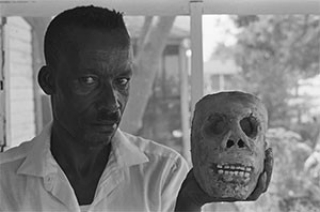Born 1926, Eden, Mississippi
Died 1993, Greenville, Mississippi
As a child, James Thomas earned his nickname by modeling Ford tractors out of the red “gumbo” clay found in the hills of Yazoo County. He later adopted the moniker as a blues performer playing the Mississippi Delta region. Thomas first learned guitar and sculpture from his uncle, and his art proved a valuable source of income, supplementing the wages he earned picking cotton and digging graves. In 1982 Thomas’s clay sculptures were featured in Black Folk Art in America, 1930–1980, organized by the Corcoran Gallery of Art in Washington, DC.
Thomas sculpted native animals, such as birds, alligators, and rattlesnakes, as well as funerary figures and busts. In 1968 he was the subject of pioneering fieldwork by folklorist William Ferris, who sought to document the persistence of African forms within material folk culture. Despite a resulting influx of outside interest, Thomas continued to make small sculptures that ingeniously negotiated the brutal privations of black life in the rural South during and after the Jim Crow era. For his best-known works, he formed rough lumps of clay into heads according to a strict economy of means. To make skulls, he lopped off the nose and bored into the other orifices, frequently hollowing out the cranium for use as a bowl or ashtray. To make portrait busts, he added details like real teeth or hair, along with decorations such as beads, foil, and wire. Thomas’s creations were displayed on the mantles or windowsills of his neighbors or were sold to collectors.
One of many such skulls, Untitled of 1988, features a gaping mouth, lined with human teeth, split into a macabre grin. The skeletal form reflects Thomas’s professed affinity for “hoodoo” beliefs. He claimed to rely on dreams as sources for both his songs and his sculptures, and many of his portrait busts evoke a dreamlike state of flux and vagueness. Others exhibit a definite sense of specificity: adorned with tufts of cotton, one fuchsia-streaked bust resembles George Washington, at once suggesting the founding of the country and the material history of slavery, whereas Untitled (self-portrait) is a probing envisioning of the self.
Jenevive Nykolak
Berger, Jonathan, and Jessica Iannuzzi Garcia, eds. James “Son Ford” Thomas: The Devil and His Blues. New York: Karma, 2017.
Ferris, William R., Jr. “‘If You Ain’t Got It In Your Head, You Can’t Do It In Your Hand’: James Thomas, Mississippi Delta Folk Sculptor.” Studies in the Literary Imagination 3 (1970): 89–107.
